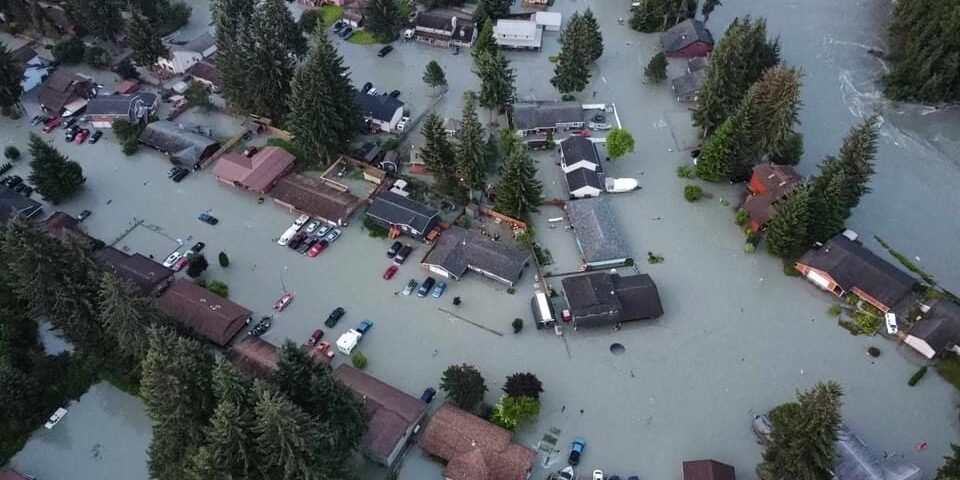In early August, for the second year in a row and on almost the exact same days as the previous year, Alaska’s capital city received historic floods. City officials announced on August 6 that Juneau flooding, caused by waters overflowing the Mendenhall River due to a glacial melt, had damaged around 290 homes and at least two businesses.
Flooding from the Mendenhall River has become an annual problem for Juneau, and in August 2023 turned into crisis for the first time when the overflow flooded streets and collapsed homes along the riverbank. The now-yearly flooding happens, according to NOAA, due to the retreat of a small glacier near the larger Mendenhall Glacier—the primary water source of the Mendenhall River—which left behind a reservoir known as Suicide Basin that fills with rain- and meltwater each spring and summer. While the larger glacier acts as a dam, once enough water collects in Suicide Basin, the pressure forces water under and around Mendenhall Glacier which then bursts into the adjacent Mendenhall Lake before flowing into the river.
While such glacial outbursts have been occurring since 2011, this year’s resulting flooding in Juneau was unprecedented: 14.6 billion cubic feet of water poured from Suicide Basin and into the Mendenhall River, which crested at nearly 16 feet—more than a foot higher than last year. Across Juneau’s Mendenhall Valley, roads flooded, power went out, and hundreds of homes were damaged. For the second time in two years, the state governor issued a disaster declaration for the community.

In 2023, Team Rubicon Alaskan Greyshirt volunteers deployed to Juneau to help the recovery after the flood. A small team spent a day alongside the City and Borough of Juneau Emergency Management and Capital City Fire & Rescue removing major debris, clearing logjams, and securing building materials and industrial refuse so the city can safely dispose of them.
Now, Greyshirts are back in Juneau, assisting the hundreds of homeowners impacted by the 2024 floods.
Responding to disasters in Alaska is uniquely challenging, explains Chandler Alford Team Rubicon’s Mission Planning Team lead for the Juneau operation. “Unlike typical flood responses in the Lower 48, where events like hurricanes provide some predictability, glacier-dammed lake outburst floods like the one in Juneau can occur suddenly, without warning,” said Alford. “Given Juneau’s isolation and limited resources, we had to act swiftly, overcoming significant logistical challenges to deliver critical support from outside the region to a community with constrained life support systems and supply options.”
Among the volunteer disaster responders responding to the Juneau flooding this year are many locals, including Greyshirt Randy Brannan, a Juneau resident and hydrologic technician with the U.S. Geological Survey.
“We’ve spoken to a number of homeowners who don’t have flood insurance. But Alaskans are hardy, everyone immediately began helping each other,” says Brannan.
For Greyshirts who have responded to floods in places like the streets of Montana and Mississippi Delta neighborhoods, the task of this cleanup is made even more interesting by its glacial nature.
“This was a flood in which the river flowed through the neighborhood,” Brannan said, “and the first thing I noticed in the morning was glacial silt all over the streets.” The massive weight and regular motion of a glacier grinds up rock and gravel into a fine sediment. Mucking out glacial silt from flooded homes, in addition to plain old mud and flotsam dredged up by the river, is a new chore for the Greyshirts.
In addition to mucking out homes and hauling away flood debris, Greyshirts have been scouring the community for additional homeowners in need who may not know there is help available—a challenge given that many of them refuse or defer assistance. “Alaskans generally don’t ask for help,” explained Brannan. “We’ll explain how we help and what we offer, and they’ll just push off our services onto ‘someone who deserves the help more.’ But we’ve identified people who do need help and we’re trying to make it happen for them.” The response operation began on Monday, August 12, and is expected to last for about a week. More than a dozen local Greyshirts, joined by others from around Alaska and even a few from the Lower 48, have signed up for the operation.



